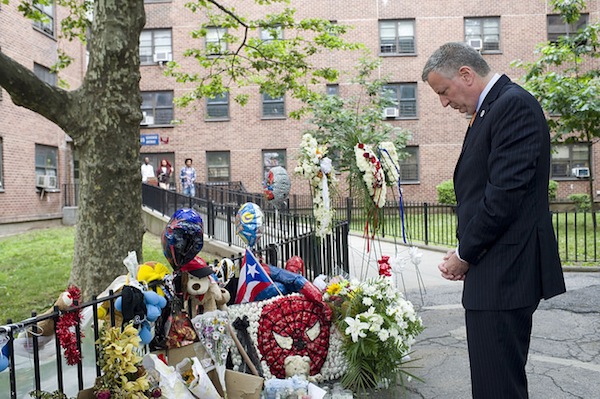
Photo by: Rob Bennett for the Office of Mayor Bill de Blasio
Mayor Bill de Blasio at Boulevard Houses in East New York.
Prince Joshua (P.J.) Avitto and Mikayla Capers should be playing right now, enjoying the warm June weather, without a care in the world. At the tender ages of six and seven, they deserve the same boundless hopes and dreams we wish for all children, with a long life full of potential and free from harm. Instead, P.J. is dead from fatal stab wounds, and Mikayla remains in critical condition in a hospital, fighting for her life.
The attack on these children in an elevator of their public housing complex is an unthinkable crime, and the pain and anguish of their family is unimaginable. As we mourn the loss of young P.J. and pray for Mikayla’s recovery, we owe it to them—as well as to their family and neighbors who live in New York City’s public housing—to avoid rushing to quick or incomplete fixes that will not adequately address the range of problems affecting the security of their homes.
For years, public housing residents have complained about broken locks and damaged intercom systems that fail to secure the entryways of their apartment buildings. And several buildings, including P.J. and Mikayla’s, do not have security cameras despite the City Council’s allocation of tens of millions of dollars specifically for that purpose. Thus, while such cameras are ubiquitous throughout New York City’s tourist destinations and private residential buildings, there were no cameras in the elevator where the children were attacked. Functioning locks, working intercom systems, and well-lit common areas are the bare minimum that public housing residents need to keep their homes safe from potential wrongdoers. Yet, such minimal security measures have been pushed aside as public housing buildings fall further into disrepair.
Police play a critical role in ensuring the safety of public housing, but their presence alone is not a solution. Indeed, in another recent tragedy, 16-year-old LaQuan Nelson was fatally shot near his public housing apartment just 100 yards from the 88th Precinct. And, unfortunately, past experiences have raised concerns about how police treat the residents they are supposed to serve. Public housing residents, many living in the same place their whole lives, have been falsely accused of trespassing by the police for doing nothing more than walking to or from their apartments. Children as young as eight years old have been stopped and asked for identification. Some residents have even been arrested for trespassing in their own homes. These risks extend to family and friends, to the point where people have been arrested for trespassing when bringing food to a sick loved one.
Instead of focusing their efforts on identifying and apprehending actual criminals, police in public housing have too often criminalized the innocent, breeding distrust and preventing the necessary cooperation to do their jobs effectively. It is no coincidence that almost 90 percent of the public housing population consists of blacks and Latinos, who also make up 84 percent of all people stopped by police. When controlling for crime, police officers make more stops—thus more stops of innocent people—in public housing than the surrounding areas before making an arrest for weapons, drugs, or violent crime offenses. On too many occasions, blacks and Latinos in public housing are seen first as potential criminals, rather than residents or guests.
More than 175,000 families live in over 2,500 public residential buildings throughout New York City. The vast majority are hard-working, law-abiding people, doing the best they can in an increasingly unaffordable city. Just like more affluent apartment buildings, these residences vary significantly in size and population, as well as crime rates. And, like their more affluent counterparts, public housing residents should not have to choose between their rights and their safety at home.
As the eyes and ears in their neighborhood, public housing residents can and should play an important role in securing their communities. That is why police must meaningfully partner with them to jointly devise safety plans that address the unique and specific circumstances of particular buildings or housing developments. The third partner is the New York City Housing Authority, which must maintain the security and integrity of its buildings, so that police involvement becomes a last resort.
There is no question that P.J. and Mikayla—and anyone else living in public housing—deserve the same safety and security as all New York City residents. One’s safety, as well as one’s rights, should not be contingent on income or zip code; they should both be guaranteed to all.








